Geometry and Kinematics of the Central Fault Zone, Fula Sag, Central Africa Shear Zone
Abstract
:1. Introduction
2. Geological Setting
3. Datasets and Methodologies
4. Structural Styles
4.1. Fault Distribution Characteristics
4.2. 3D Visualization of the Transfer Zone
5. Fault Throw Analysis
6. Growth Analysis of the Main Faults
7. Discussion
7.1. Kinematics of the Study Area
7.2. Insights for Hydrocarbon Exploration
7.3. Study Limitations
8. Conclusions
- (1)
- The three rifting cycles of the Fula sag were subject to the segmental expansion of the Atlantic Ocean, the rapid opening of the Indian Ocean, and the separation of the Red Sea, respectively. During the first rifting, the boundary faults of the Fula sag began to develop, resulting in a nearly NS-trending tectonic pattern in the Fula sag; during the second rifting, the southwestern fault-array-and-ramp zone and the CFZ began to develop, forming the tectonic pattern of “overall NS-trending, internal tectonic NW-trending” in the Fula sag; during the third rifting, the northeastern fault-array-and-ramp zone began to form.
- (2)
- The relative dip direction of the two faults involving F1 and F3 is divergent. The map position of the fault relative to the other is overlapping. The tectonic style in the middle section is a horst. Hence, we interpret the Fula-Moga transfer zone as the divergent overlapping type. The main faults F1, F3, and F2 of the CFZ are laterally segmented into 4, 4, and 3 fault segments, respectively.
- (3)
- The main faults comprising the CFZ have been active mainly since the second rifting. The fault segments that make up the main faults were in the isolated growth stage during the syn-rift period of the second rifting, entered the soft-linkage stage in the post-rift period of the second rifting, and went through the hard-linkage stage before finally forming a fully grown, large fault in the third rifting. The above faults weakened abruptly in activity intensity during the transition period between the last two rifting cycles.
Author Contributions
Funding
Institutional Review Board Statement
Informed Consent Statement
Data Availability Statement
Acknowledgments
Conflicts of Interest
References
- Frankowicz, E.; McClay, K.R. Extensional fault segmentation and linkages, Bonaparte Basin, outer North West Shelf, Australia. AAPG Bull. 2010, 94, 977–1010. [Google Scholar] [CrossRef]
- Henstra, G.A.; Gawthorpe, R.L.; Helland-Hansen, W.; Ravnås, R.; Rotevatn, A. Depositional systems in multiphase rifts: Seismic case study from the Lofoten margin, Norway. Basin Res. 2017, 29, 447–469. [Google Scholar] [CrossRef]
- Kairanov, B.; Marín, D.; Escalona, A.; Cardozo, N. Growth and linkage of a basin-bounding fault system: Insights from the Early Cretaceous evolution of the northern Polhem Subplatform, SW Barents Sea. J. Struct. Geol. 2019, 124, 182–196. [Google Scholar] [CrossRef]
- Gartrell, A.; Bailey, W.R.; Brincat, M. A new model for assessing trap integrity and oil preservation risks associated with post rift fault reactivation in the Timor Sea. AAPG Bull. 2006, 90, 1921–1944. [Google Scholar] [CrossRef]
- Yielding, G.; Freeman, B. 3-D seismic-structural workflows–examples using the hat creek fault system. 3-D Struct. Interpret. Earth Mind Mach. 2016, 10, 155–171. [Google Scholar] [CrossRef]
- Chen, B.K.; He, J.J.; Pigott, J.D. A discussion on evolution mechanism of the central fault belt in the tertiary Dongying depression, east China. J. Chengdu Univ. Technol. Sci. Technol. Ed. 2000, 27, 359–367. [Google Scholar] [CrossRef]
- Wan, X.L.; Qiu, N.S.; Li, L.; Zeng, J.H. Abnormal high-pressure of early Tertiary in Dongying depression and its response to hydrocarbon accumulation. Nat. Gas Geosci. 2004, 15, 95–98. [Google Scholar] [CrossRef]
- Zhang, S.P.; Lu, B.F.; Xia, B.; Liu, G.D. The Cenozoic structural transition and its significance for petroleum accumulation in Dongying sag, Shandong. Geotecton. Met. 2007, 31, 281–287. [Google Scholar] [CrossRef]
- Jiang, F.J.; Jiang, Z.X.; Pang, X.Q. Division and quantitative evaluation of petroleum accumulation system in Dongying sag. Earth Sci. 2008, 33, 651–660. [Google Scholar] [CrossRef]
- Li, C.Q.; Xu, J.H.; Hao, X.W.; Zhou, L.J.; Wang, S.W. Multiple reservoir features of western central uplift zone in Huimin sag. Xinjiang Oil Gas 2003, 15, 9–12. [Google Scholar] [CrossRef]
- Wang, K.; Cha, M. Rules of event accumulation of hydrocarbon in central uplift belt in Huimin depression. J. Oil Gas Technol. 2008, 30, 5–9. [Google Scholar] [CrossRef]
- Cai, N.; Han, Z.Z. The tectonic characteristics of the central uplift belt and its evolution history in the Huimin depression. J. Shandong Univ. Sci. Technol. Nat. Sci. 2010, 29, 26–29. [Google Scholar] [CrossRef]
- Cai, Q.S.; Hu, M.Y.; Hu, Z.G.; Wang, D.D. Reservoir characteristics and evolution of diagenetic porosity of Huagang Formation of Paleogene in the central anticlinal belt of Xihu sag, Donghai Basin. Nat. Gas Geosci. 2013, 24, 733–740. [Google Scholar] [CrossRef]
- Lou, M.; Yang, X.H.; Jang, P.; Huo, S.J. Reservoir diagenetic facies logging identification of Huagang Formation in central northern of the central anticlinal belt of Xihu sag. Pet. Geol. Eng. 2019, 33, 6–10. [Google Scholar] [CrossRef]
- Zhang, G.Y.; Yu, Z.H.; Chen, Z.M.; Zhang, D.Q.; Wen, Z.X.; Huang, T.F.; Wang, Y.Q.; Liu, X.B.; Ma, F.; Zhao, J. Tectonic evolution and hydrocarbon distribution in African basins. Earth Sci. Front. 2018, 25, 1–14. [Google Scholar] [CrossRef]
- Zhang, G.Y.; Yu, Z.H.; Huang, T.F.; Cheng, D.S.; Chen, Z.M.; Chen, X.; Liu, H.; Song, C.P. Types and hydrocarbon accumulation characteristics of rift basins in Africa. China Pet. Explor. 2020, 25, 43–51. [Google Scholar] [CrossRef]
- Tong, X.G.; Dou, L.R.; Tian, Z.J.; Pan, X.H.; Zhu, X.D. Geological mode and hydrocarbon accumulation mode in Muglad passive rift basin of Sudan. Acta Pet. Sin. 2004, 25, 19–24. [Google Scholar] [CrossRef]
- Zhang, Y.M.; Chen, F.J. The development feature and hydrocarbon exploration potential in Muglud Basin. Oil Gas Geol. 2002, 23, 236–240. [Google Scholar] [CrossRef]
- Wang, X.L.; Wang, W.Q.; Li, S.Z.; Zhang, Y.M.; Fang, J.M. Structural feature of M Basin and its relation to oil and gas. Oil Gas Geol. 2000, 21, 76–79. [Google Scholar] [CrossRef]
- Wang, Y.Q.; Zhang, G.Y.; Liu, A.X.; Huang, T.F.; Ke, W.L. Fault characteristics of Fula sag, Muglad Basin in central Africa. Chin. J. Geol. 2019, 54, 145–158. [Google Scholar] [CrossRef]
- Wei, Y.P.; Liu, C.Y. Geological model of the Mugland Basin -an identical example of basin evolution at the end of giant strike-slip faults. Pet. Geol. Exp. 2003, 25, 129–136. [Google Scholar] [CrossRef]
- Wang, G.L.; Wang, W.Q.; Zheng, Y.L.; Pan, C.F. New progress in petroleum geology and new field of exploration in the Muglad Basin, Sudan. Earth Sci. Front. 2018, 25, 33–41. [Google Scholar] [CrossRef]
- Zhang, G.Y.; Huang, T.F.; Liu, J.G.; Yu, Z.H.; Zhao, Y.; Liu, A.X.; Ke, W.L.; Wang, Y.Q. Multi-cycle evolution of the intracontinental passive rift basins and its controlling on accumulation of oil & gas: Taking Muglad Basin in Africa as an example. Acta Petrol. Sin. 2019, 35, 1194–1212. [Google Scholar] [CrossRef]
- Zhang, Y.M.; Chen, F.J. Structure accommodation zone and exploration prospect in Muglad Basin. China Pet. Explor. 2006, 11, 79–83. [Google Scholar] [CrossRef]
- Wang, W.Q.; Dou, L.R.; Zhang, Z.W.; Li, Z.; Li, Q. Transfer zone character and its relationship to hydrocarbon in Fula sag, Sudan. Pet. Explor. Dev. 2007, 34, 124–127. [Google Scholar] [CrossRef]
- Wu, D.; Zhu, X.M.; Liu, C.N.; Nan, Z.B.; Shi, Y.L. Significance of central transfer zone on lithologic reservoir exploration: A case of Abu Gabra Formation in Fula sag, Muglad Basin, Sudan. Lithol. Reserv. 2017, 29, 64–72. [Google Scholar] [CrossRef]
- Morley, C.K.; Nelson, R.A.; Patton, T.L.; Munn, S.G. Transfer zones in the East African Rift System and their relevance to hydrocarbon exploration in rifts. AAPG Bull. 1990, 74, 1234–1253. [Google Scholar] [CrossRef]
- Peacock, D.C.P.; Sanderson, D.J. Geometry and Development of Relay Ramps in Normal Fault Systems. AAPG Bull. 1994, 78, 147–165. [Google Scholar] [CrossRef]
- Trudgill, B.; Cartwright, J. Relay-ramp forms and normal-fault linkages, Canyonlands National Park, Utah. GSA Bull. 1994, 106, 1143–1157. [Google Scholar] [CrossRef]
- Cartwright, J.A.; Trudgill, B.D.; Mansfield, C.S. Fault growth by segment linkage: An explanation for scatter in maximum displacement and trace length data from the Canyonlands Grabens of SE Utah. J. Struct. Geol. 1995, 17, 1319–1326. [Google Scholar] [CrossRef]
- Childs, C.; Watterson, J.; Walsh, J.J. Fault overlap zones within developing normal fault systems. J. Geol. Soc. 1995, 152, 535–549. [Google Scholar] [CrossRef]
- Imber, J.; Tuckwell, G.W.; Childs, C.; Walsh, J.J.; Manzocchi, T.; Heath, A.E.; Bonson, C.G.; Strand, J. Three-dimensional distinct element modelling of relay growth and breaching along normal faults. J. Struct. Geol. 2004, 26, 1897–1911. [Google Scholar] [CrossRef]
- Soliva, R.; Benedicto, A. A linkage criterion for segmented normal faults. J. Struct. Geol. 2004, 26, 2251–2267. [Google Scholar] [CrossRef]
- Hus, R.; Acocella, V.; Funiciello, R.; De Batist, M. Sandbox models of relay ramp structure and evolution. J. Struct. Geol. 2005, 27, 459–473. [Google Scholar] [CrossRef]
- Fossen, H.; Rotevatn, A. Fault linkage and relay structures in extensional settings—A review. Earth Sci. Rev. 2016, 154, 14–28. [Google Scholar] [CrossRef]
- Fu, X.F.; Sun, B.; Wang, H.X.; Meng, L.D. Fault segmentation growth quantitative characterization and its application on sag hydrocarbon accumulation research. J. China Univ. Min. Technol. 2015, 44, 271–281. [Google Scholar] [CrossRef]
- Chapman, T.J.; Meneilly, A.W. The displacement patterns associated with a reverse-reactivated, normal growth fault. Geol. Soc. Lond. Spec. Publ. 2022, 56, 183–191. [Google Scholar] [CrossRef]
- Childs, C.; Easton, S.J.; Vendeville, B.C.; Jackson, M.P.A.; Lin, S.T.; Walsh, J.J.; Watterson, J. Kinematic analysis of faults in a physical model of growth faulting above a viscous salt analogue. Tectonophysics 1993, 228, 313–329. [Google Scholar] [CrossRef]
- Rowan, M.G.; Hart, B.S.; Nelson, S.; Flemings, P.B.; Trudgill, B.D. Three-dimensional geometry and evolution of a salt-related growth-fault array: Eugene Island 330 field, offshore Louisiana, Gulf of Mexico. Mar. Pet. Geol. 1998, 15, 309–328. [Google Scholar] [CrossRef]
- Watterson, J. Fault dimensions, displacements and growth. Pure Appl. Geophys. Pageoph. 1986, 124, 365–373. [Google Scholar] [CrossRef]
- Walsh, J.J.; Watterson, J. Analysis of the relationship between displacements and dimensions of faults. J. Struct. Geol. 1988, 10, 239–247. [Google Scholar] [CrossRef]
- Cowie, P.A.; Scholz, C.H. Displacement-length scaling relationship for faults: Data synthesis and discussion. J. Struct. Geol. 1992, 14, 1149–1156. [Google Scholar] [CrossRef]
- Xu, S.S.; Nieto-Samaniego, A.; Li, D.X. Relationship between fault length and maximum displacement and influenced factors. Earth Sci. Front. 2004, 11, 567–573. [Google Scholar] [CrossRef]
- Zhang, G.Y.; Huang, T.F.; Liu, J.G.; Li, Y.J.; Du, Y.B.; Yu, Z.H.; Zhang, X.S.; Yu, Z.H. Formation and evolution of West and Central African superimposed rift basins. Acta Petrol. Sin. 2022, 38, 2539–2553. [Google Scholar] [CrossRef]
- Guiraud, R.; Maurin, J.-C. Early Cretaceous rifts of Western and Central Africa: An overview. Tectonophysics 1992, 213, 153–168. [Google Scholar] [CrossRef]
- Genik, G.J. Petroleum geology of Cretaceous-Tertiary rift basins in Niger, Chad, and Central African Republic. AAPG Bull. 1993, 77, 1405–1434. [Google Scholar] [CrossRef]
- Fairhead, J.D.; Binks, R.M. Differential opening of the Central and South Atlantic Oceans and the opening of the West African rift system. Tectonophysics 1991, 187, 191–203. [Google Scholar] [CrossRef]
- Fairhead, J.D. The West and Central African rift systems: Foreword. Tectonophysics 1992, 213, 139–140. [Google Scholar] [CrossRef]
- Suo, Y.H. Tectonic-Magmatic Processes of the Indian Ocean: Evidence on the Residual Mantle Bouguer Anomaly. Ph.D. Thesis, Ocean University of China, Qingdao, China, 2014. [Google Scholar]
- Binks, R.M.; Fairhead, J.D. A plate tectonic setting for Mesozoic rifts of West and Central Africa. Tectonophysics 1992, 213, 141–151. [Google Scholar] [CrossRef]
- Sun, H.T.; Zhong, D.K.; Zhang, S.M. Difference in hydrocarbon distribution in passive margin basins of east and west Africa. Pet. Explor. Dev. 2010, 37, 561–567. [Google Scholar]
- Fadul, M.F.; El Dawi, M.G.; Abdel-Fattah, M.I. Seismic interpretation and tectonic regime of Sudanese Rift System: Implications for hydrocarbon exploration in Neem field (Muglad Basin). J. Pet. Sci. Eng. 2020, 191, 107223. [Google Scholar] [CrossRef]
- Fairhead, J.D.; Chris, G.; Masterton, S.M.; Sheona, M.; Guiraud, R. The role that plate tectonics, inferred stress changes and stratigraphic unconformities have on the evolution of the West and Central African Rift System and the Atlantic continental margins. Tectonophysics 2013, 594, 118–127. [Google Scholar] [CrossRef]
- Mohamed, A.Y.; Mustafa, M.H.; Osman, A.; Osman, M.A.; Gabor, K.; Mohammed, M. Evolution history of transtensional pull-apart, oblique rift basin and its implication on hydrocarbon exploration: A case study from Sufyan Sub-basin, Muglad Basin, Sudan. Mar. Pet. Geol. 2017, 79, 282–299. [Google Scholar] [CrossRef]
- Wu, D.; Zhu, X.M.; Li, Z.; Su, Y.D.; Liu, Y.H.; Zhang, M.Y.; Song, J.F.; Liu, A.X.; Chen, X.Y.; Zhao, D.N. Depositional models in Cretaceous rift stage of Fula sag, Muglad Basin, Sudan. Pet. Explor. Dev. 2015, 42, 348–357. [Google Scholar] [CrossRef]
- Lu, Y.C.; He, B.Z.; Wang, X.L.; Wang, W.Q. Petroleum geologic characteristics and exploration prospect of Fula sub-basin in Muglad Basin. Pet. Explor. Dev. 2001, 28, 95–98. [Google Scholar] [CrossRef]
- Lister, D.L. Modelling fault geometry and displacement for very large networks. Geol. Soc. Lond. Mem. 2004, 29, 339–355. [Google Scholar] [CrossRef]
- Dutton, D.M.; Lister, D.; Trudgill, B.D.; Pedro, K. Three-dimensional geometry and displacement configuration of a fault array froma raft system, Lower Congo Basin, Offshore Angola: Implications for the Neogene turbidite play. Geol. Soc. Lond. Mem. 2004, 29, 133–142. [Google Scholar] [CrossRef]
- Peacock, D.C.P.; Knipe, R.J.; Sanderson, D.J. Glossary of normal faults. J. Struct. Geol. 2000, 22, 291–305. [Google Scholar] [CrossRef]
- Chen, F.J.; Wang, X.W.; Chen, Z.N. Analysis of transform structures in extensional fault depressions. Geoscience 2011, 25, 617–625. [Google Scholar] [CrossRef]
- Maurin, J.-C.; Guiraud, R. Basement control in the development of the early cretaceous West and Central African rift system. Tectonophysics 1993, 228, 81–95. [Google Scholar] [CrossRef]
- Li, J.H.; Wang, H.H.; Li, W.B.; Zhou, X.B. Discussion on global tectonics evolution from plate reconstruction in Phanerozoic. Acta Pet. Sin. 2014, 35, 207–218. [Google Scholar] [CrossRef]
- Dou, L.R.; Cheng, D.S.; Li, Z.; Zhang, Z.W.; Wang, J.C. Petroleum geology of the Fula Sub-basin, Sudan. J. Pet. Geol. 2013, 36, 43–59. [Google Scholar] [CrossRef]
- Li, W.; Dou, L.R.; Zhang, G.Y.; Cheng, D.S.; Wen, Z.G.; Liu, A.X.; Ke, W.L. Geochemical characteristics of crude oil and their implications for hydrocarbon accumulation in the Fula Sub-basin, Muglad Basin, Sudan. Earth Sci. Front. 2018, 25, 121–129. [Google Scholar] [CrossRef]



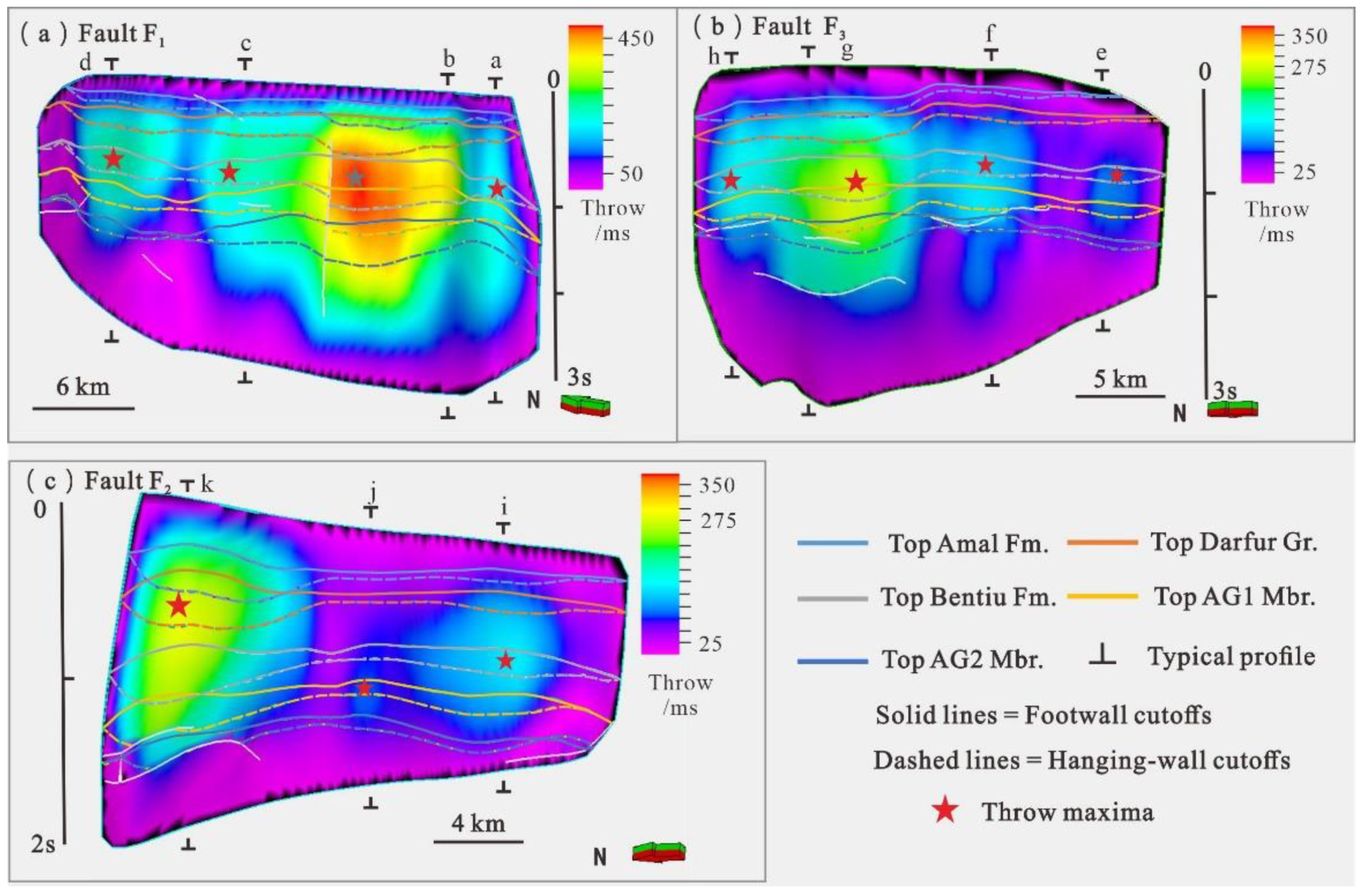
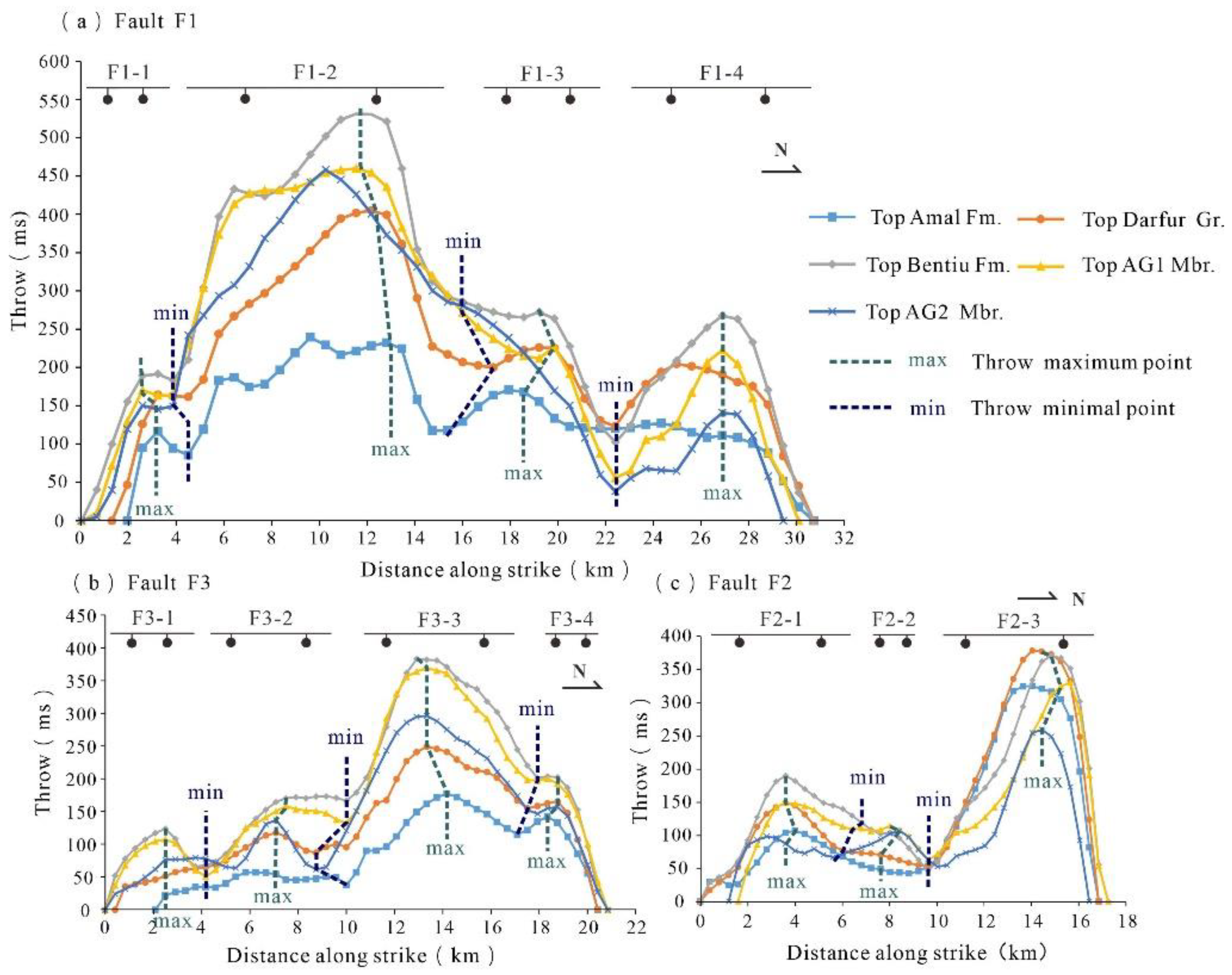
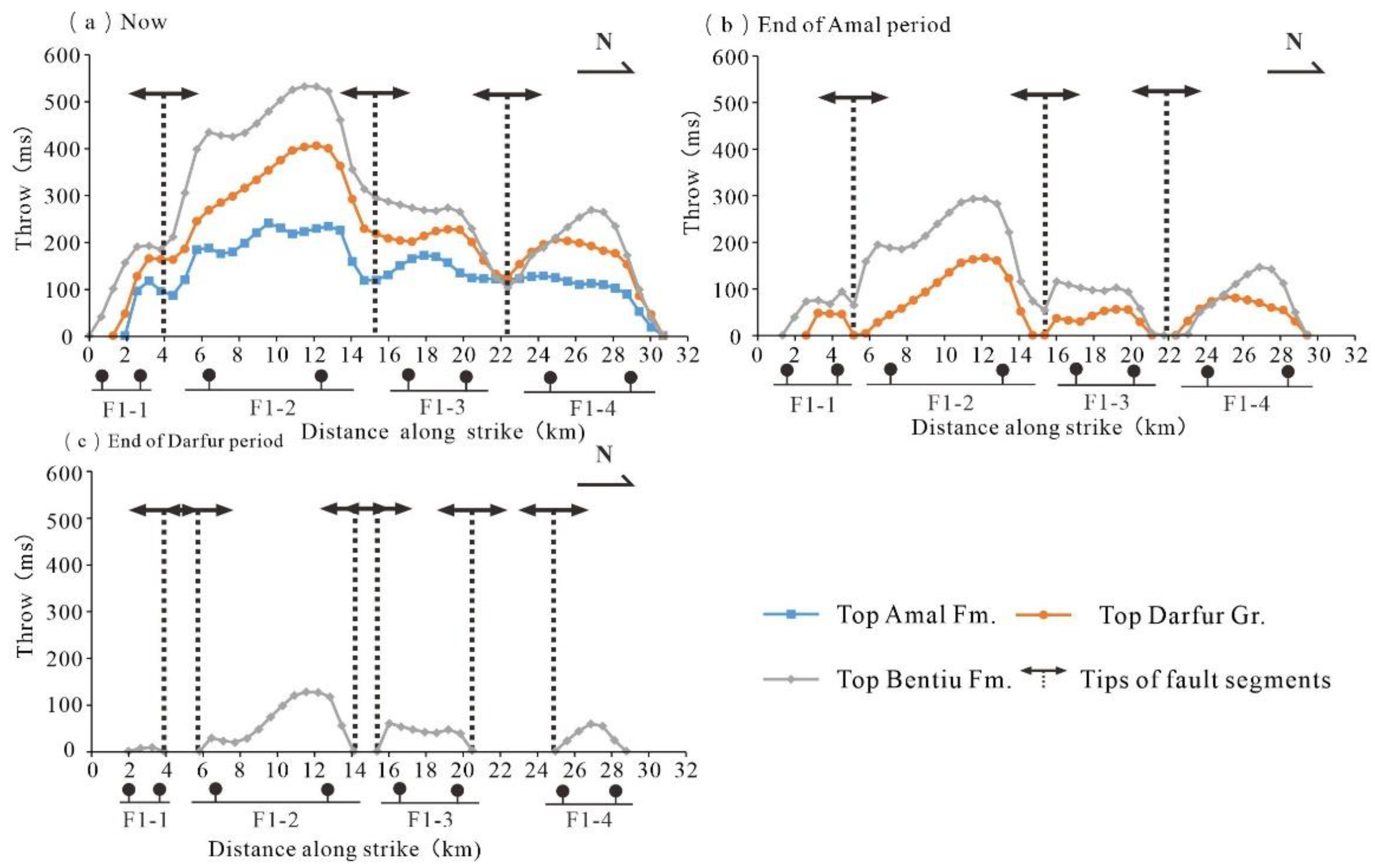
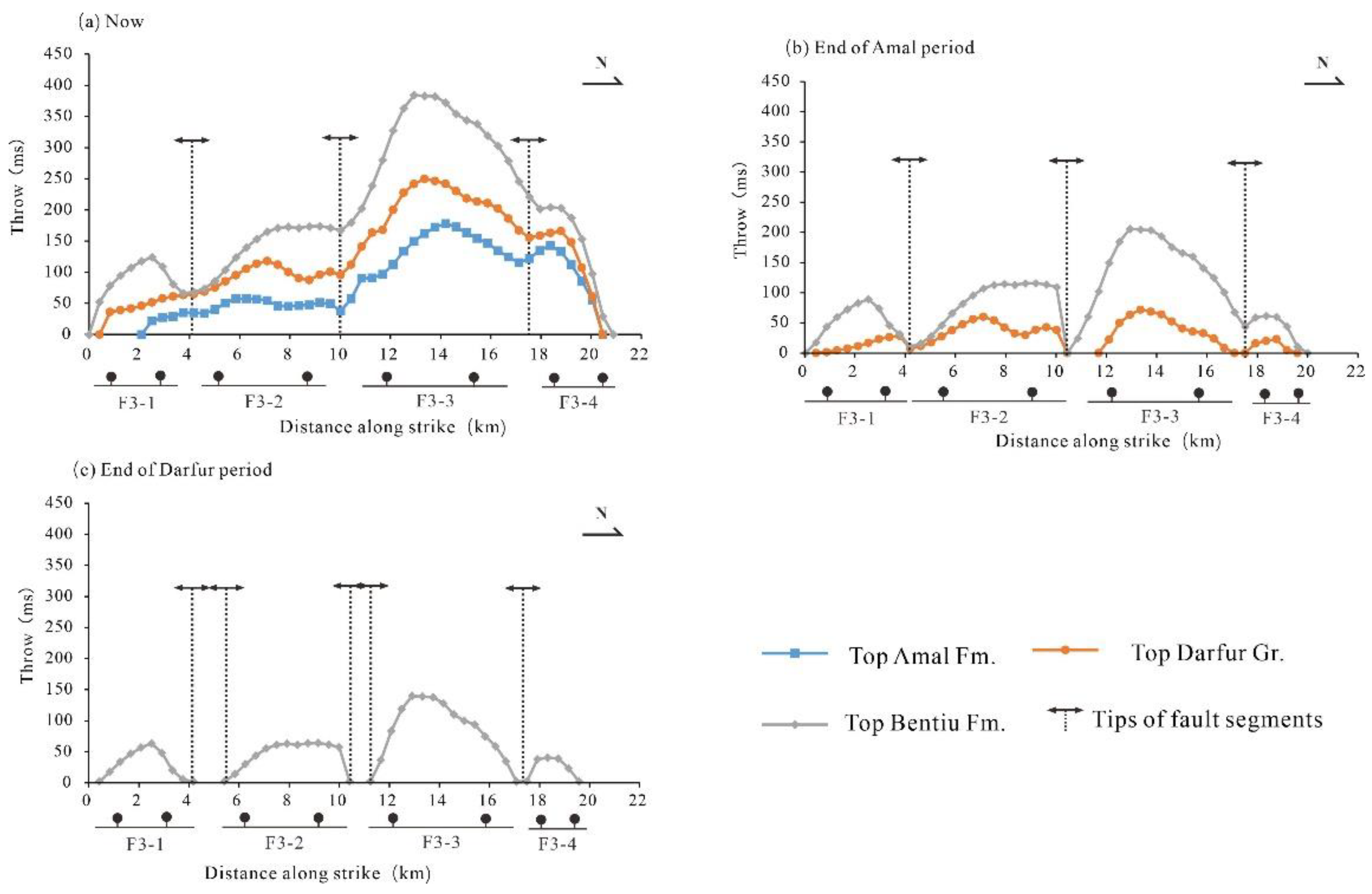
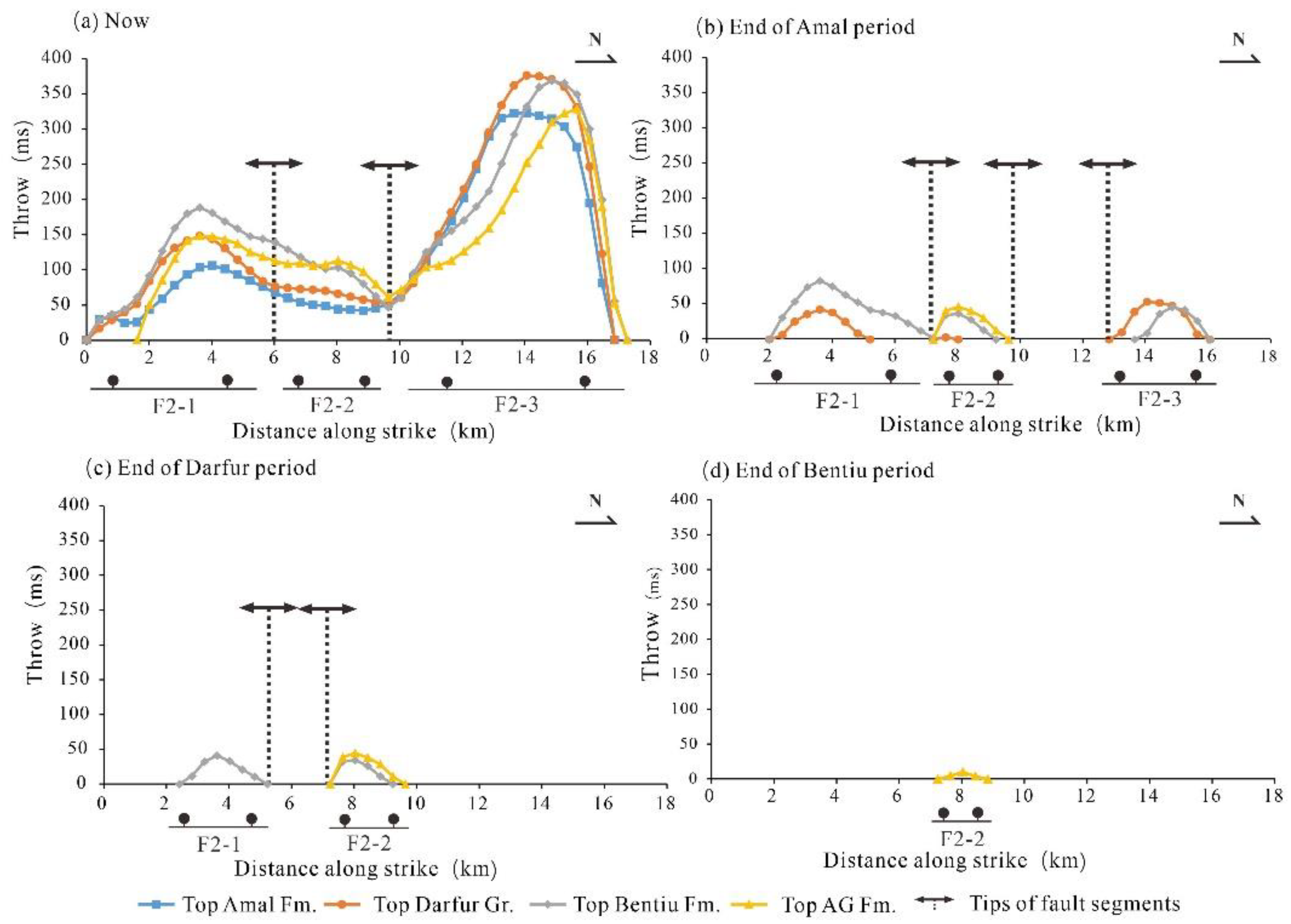
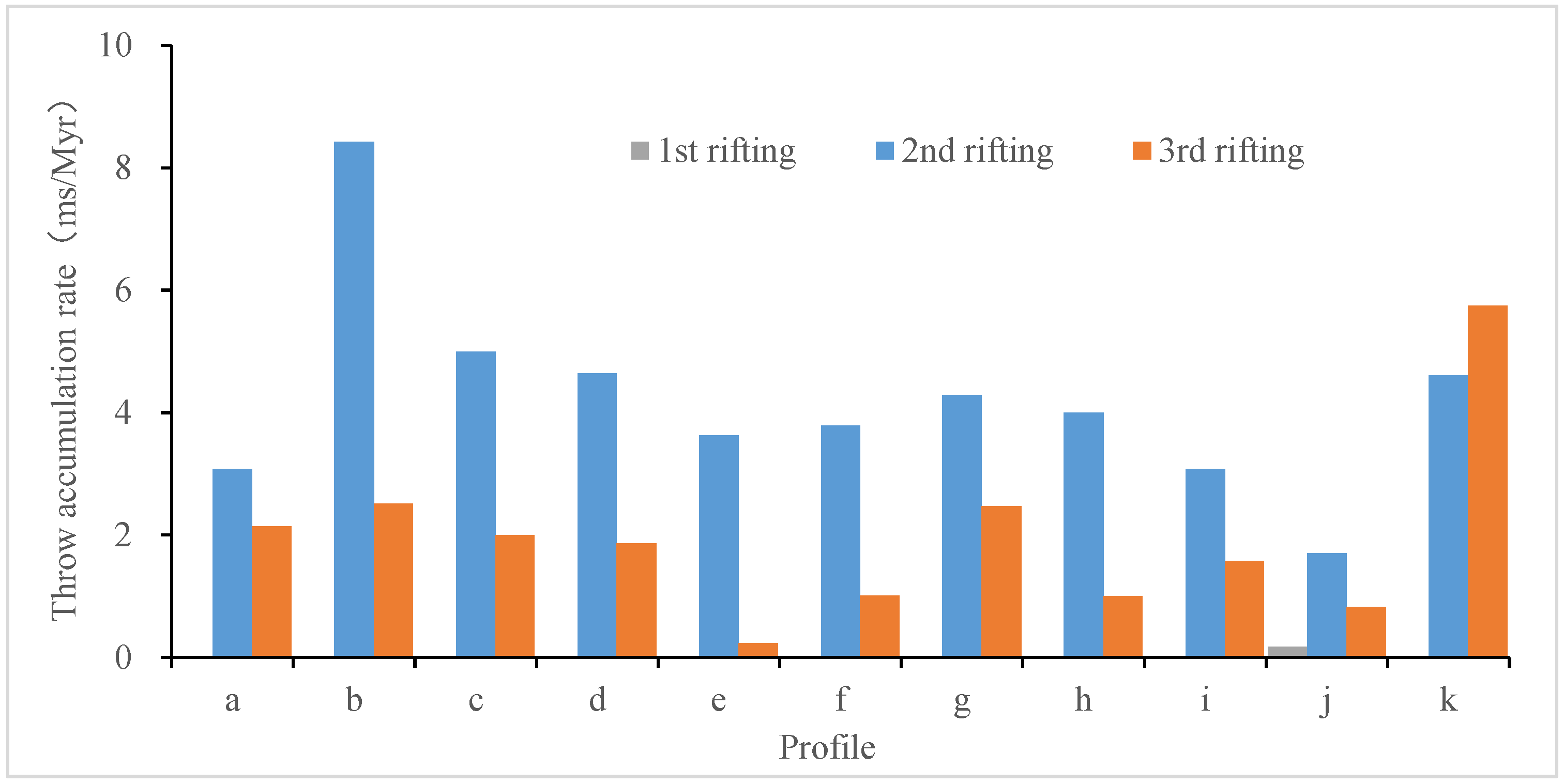
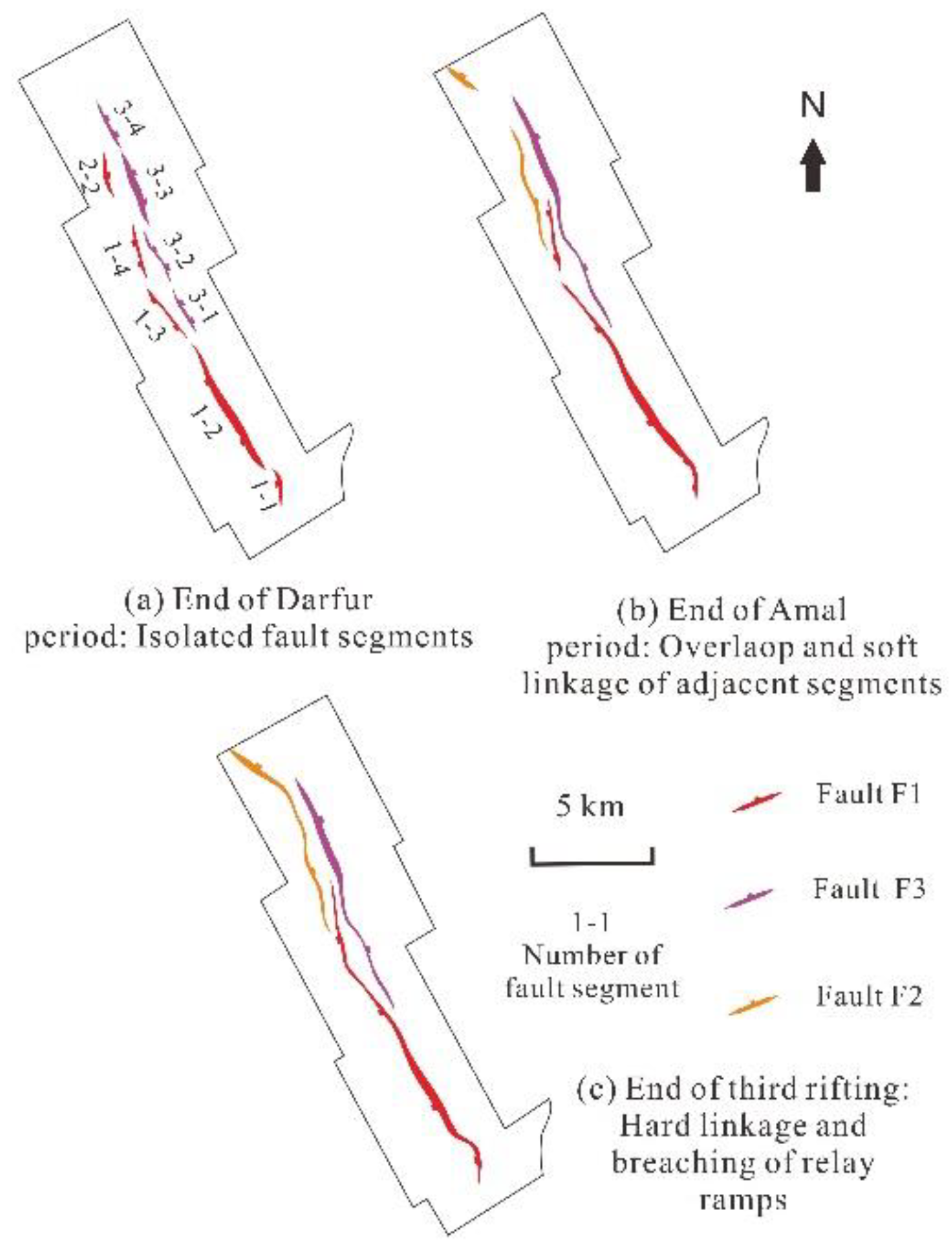

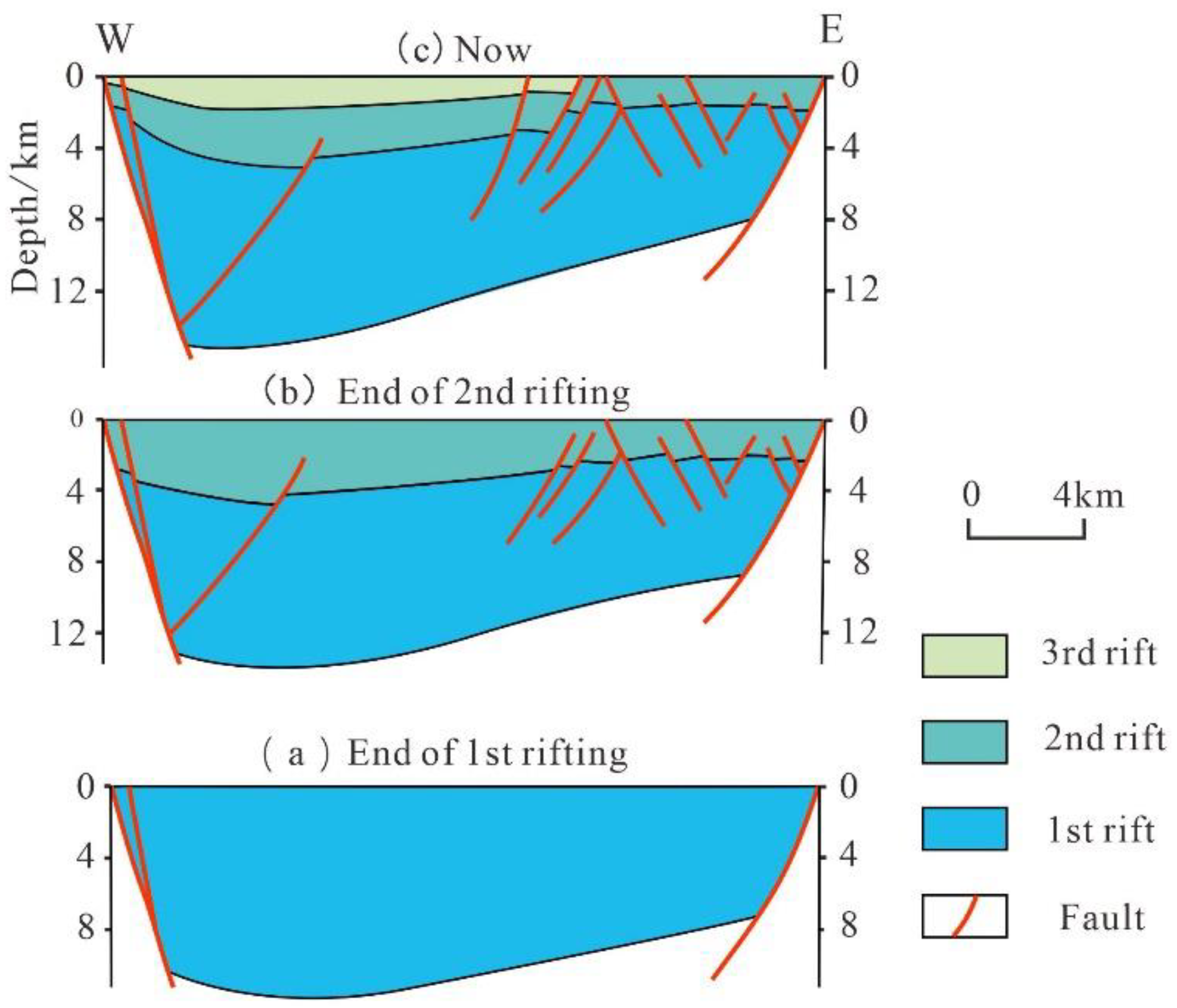
Disclaimer/Publisher’s Note: The statements, opinions and data contained in all publications are solely those of the individual author(s) and contributor(s) and not of MDPI and/or the editor(s). MDPI and/or the editor(s) disclaim responsibility for any injury to people or property resulting from any ideas, methods, instructions or products referred to in the content. |
© 2023 by the authors. Licensee MDPI, Basel, Switzerland. This article is an open access article distributed under the terms and conditions of the Creative Commons Attribution (CC BY) license (https://creativecommons.org/licenses/by/4.0/).
Share and Cite
Wang, Y.; Zhang, G.; Wei, G.; Chen, Z.; Ren, R.; Zhang, Y.; Geng, K. Geometry and Kinematics of the Central Fault Zone, Fula Sag, Central Africa Shear Zone. Appl. Sci. 2023, 13, 9117. https://doi.org/10.3390/app13169117
Wang Y, Zhang G, Wei G, Chen Z, Ren R, Zhang Y, Geng K. Geometry and Kinematics of the Central Fault Zone, Fula Sag, Central Africa Shear Zone. Applied Sciences. 2023; 13(16):9117. https://doi.org/10.3390/app13169117
Chicago/Turabian StyleWang, Yanqi, Guangya Zhang, Guoqi Wei, Zhuxin Chen, Rong Ren, Yuqing Zhang, and Ke Geng. 2023. "Geometry and Kinematics of the Central Fault Zone, Fula Sag, Central Africa Shear Zone" Applied Sciences 13, no. 16: 9117. https://doi.org/10.3390/app13169117



